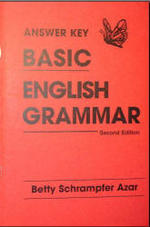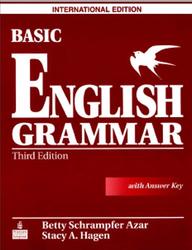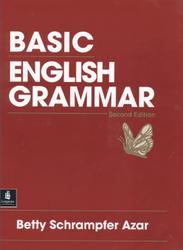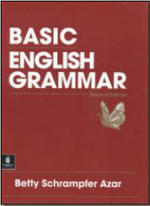Автор: Betty Azar.
2003.
The Third Edition of Fundamentals of English Grammar combines communicative methods with the direct teaching of grammar. While retaining its characteristic clarity and simplicity in grammar instruction, this edition is enriched by a wide variety of language-learning activities for the classroom.
Key features of the Third Edition:
Numerous real communication opportunities using the students' lives as context.
More interactive work in pairs and groups.
Error-analysis exercises in every chapter.
New exercises on form and meaning.
Open-ended tasks for both speaking and writing. · Additional passages using target structures in extended contexts.
Two Appendices, one with phrasal verbs, one with preposition combinations.
Workbook devoted solely to self-study exercises.
Student Book available with or without Answer Key.
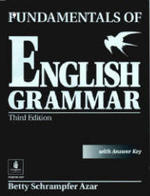
Fundamentals of English Grammar is a developmental skills text for lower-intermediate
and intermediate students of English as a second or foreign language. It combines clear
and understandable grammar information with a variety of exercises and activities.
Fundammtal of English Grammar is the second in a series of three texts: Bick English
Grammar (red cover), Fundamental of English Grammar (black cover), and Understanding
and Using English Grammar (blue cover). The principal aims of all three texts in this series are to present clear, cogent
information about English grammar and usage, to provide extensive and varied practice
that encourages growth in all areas of language use, and to be interesting, useful, and fun
for student and teacher alike. The approach is eclectic, with the texts seeking to balance
form-focused language-learning activities with abundant opportunities for engaged and
purposeful communicative interaction.
CONTENTS
Preface to the Third Edition
Acknowledgments
Chapter 1 PRESENT TIME
I-l The simple present and the present progressive 4
1-2 Forms of the simple present and the present progressive 4
1-3 Frequency adverbs 9
1-4 Final -s 12
1-5 Spelling of final -s/-es L3
1-6 Non-action verbs 17
1-7 Present verbs: short answers to yes/no questions 19
Chapter 2 PAST TIME
2-1 Expressing past time: the simple past 25
2-2 Forms of the simple past: regular verbs 26
2-3 Forms of the simple past: be 26
2-4 Regular verbs: pronunciation of -ed endings 28
2-5 Spelling oi-ing and -erfforms 29
2-6 The principal parts of a verb 32
2-7 Irregular verbs: a reference list 33
2-8 The simple past and the past progressive 39
2-9 Forms of the past progressive 39
2-10 Expressing past time: using time clauses 48
2-11 Expressing past habit: used to 52
Chapter 3 FUTURE TIME
3-1 Expressing future time: be going to and -will 56
3-2 Forms with be going to 56
3-3 Forms with -will 59
3-4 Sureness about the future 60
3-5 Be going to vs will 63
3-6 Expressing the future in time clauses and ^/-clauses 65
3-7 Using the present progressive to express future time 70
3-8 Using the simple present to express future time 73
3-9 Immediate future: using be about to 74
3-10 Parallel verbs 76
Chapter 4 THE PRESENT PERFECT AND THE PAST PERFECT
4-1 Past participle 84
4-2 Forms of the present perfect 85
4-3 iMeanings of the present perfect 86
4-4 Simple past vs present perfect 87
4-5 Using since and/or 95
4-6 Present perfect progressive 98
4-7 Present perfect progressive vs present perfect 100
4-8 Using already, yet, still, and anymore 102
4-9 Past perfect 112
Chapter 5 ASKING QUESTIONS
5-1 Yes/no questions and short answers 121
5-2 Yes/no questions and information questions 123
5-3 Where, why, zuhen, and what time 124
5-4 Questions with who, who(m), and what 125
5-5 Spoken and written contractions with question words 128
5-6 Using what + a form of do 130
5-7 Using what kind of 132
5-8 Using which 133
5-9 Using whose 135
5-10 Using how 138
5-11 Using how often 139
5-12 Using how far 140
5-13 Length of time: it + take and how long 141
5-14 More questions with how 143
5-15 Using how about and what about 149
5-16 Tag questions 152
Chapter 6 NOUNS AND PRONOUNS
6-1 Pronunciation of final -sl-es 157
6-2 Plural forms of nouns 158
6-3 Subjects, verbs, and objects 159
6-4 Objects of prepositions 161
6-5 Prepositions of time 163
6-6 Word order: place and time 164
6-7 Subject-verb agreement 165
6-8 Using adjectives to describe nouns 166
6-9 Using nouns as adjectives 168
6-10 Personal pronouns: subjects and objects 171
6-11 Possessive nouns 173
6-12 Possessive pronouns and adjectives 176
6-13 Reflexive pronouns 178
6-14 Singular forms of other: another vs the other 181
6-15 Plural forms of other: other(s) vs the other(s) 183
6-16 Summary of forms of other 186
Chapter 7 MODAL AUXILIARIES
7-1 The form of modal auxiliaries 190
7-2 Expressing ability: can and could 191
7-3 Expressing possibility: may and might
Expressing permission: may and can 193
7-4 Using could to express possibility 195
7-5 Polite questions: may 1, could I, can I 197
7-6 Polite questions: would you, could you, will you, can you 199
7-7 Expressing advice: should and ought to 202
7-8 Expressing advice: had better 203
7-9 Expressing necessity: have to, have got to, must 206
7-10 Expressing lack of necessity: do not have to
Expressing prohibition: must not 207
7-11 Making logical conclusions: must 210
7-12 Giving instructions: imperative sentences 213
7-13 Making suggestions: let's and why don't 215
7-14 Stating preferences: prefer, like better, -would rather 218
Chapter 8 CONNECTING IDEAS
8-1 Connecting ideas with and 226
8-2 Connecting ideas with but and or 228
8-3 Connecting ideas with so 230
8-4 Using auxiliary verbs after but and and 233
8-5 Using and + too, so, either, neither 235
8-6 Connecting ideas with because 239
8-7 Connecting ideas with even though!although 241
Chapter 9 COMPARISONS
9-1 Making comparisons with as as 248
9-2 Comparative and superlative 252
9-3 Comparative and superlative forms of adjectives and adverbs 253
9-4 Completing a comparative 257
9-5 Modifying comparatives 258
9-6 Comparisons with less than and not as as 259
9-7 Unclear comparisons 260
9-8 Using more with nouns 261
9-9 Repeating a comparative 262
9-10 Using double comparatives 263
9-11 Using superlatives 265
9-12 Using the same, similar, different, like, alike 271
Chapter 10 THE PASSIVE
10-1 Active sentences and passive sentences 276
10-2 Form of the passive 277
10-3 Transitive and intransitive verbs 280
10-4 Using the 6y-phrase 282
10-5 The passive forms of the present and past progressive 287
10-6 Passive modal auxiliaries 288
10-7 Using past participles as adjectives (stative passive) 292
10-8 Participial adjectives: -ed vs -ing 297
10-9 Get + adjective; get + past participle 300
10-10 Using be used/accustomed to and get used/accustomed to 303
10-11 Used to vs be used to 305
10-12 Using be supposed to 307
Chapter 11 COUNT/NONCOUNT NOUNS AND ARTICLES
11-1 A vs an 312
11-2 Count and noncount nouns 313
11-3 Noncount nouns 314
11-4 More noncount nouns 315
11-5 Using several, a lot of, many/much, and a few/a little 318
11-6 Nouns that can be count or noncount 322
11-7 Using units of measure with noncount nouns 324
11-8 Guidelines for article usage 326
11-9 Using the or 0 with names 338
11-10 Capitalization 339
Chapter 12 ADJECTIVE CLAUSES
12-1 Adjective clauses: introduction 343
12-2 Using who and whom in adjective clauses 344
12-3 Using -who, u}ho(m), and that in adjective clauses 347
12-4 Using -which and that in adjective clauses 348
12-5 Singular and plural verbs in adjective clauses 354
12-6 Using prepositions in adjective clauses 355
12-7 Using whose in adjective clauses 359
Chapter 13 GERUNDS AND INFINITIVES
13-1 Verb + gerund 368
13-2 Go + -ing 372
13-3 Verb + infinitive 373
13-4 Verb + gerund or infinitive 374
13-5 Preposition + gerund 381
13-6 Using by and with to express how something is done 384
13-7 Using gerunds as subjects; using it + infinitive 387
13-8 It + infinitive: using/or (someone) 388
13-9 Expressing purpose with in order to and for 391
13-J0 Using infinitives with too and enough 394
Chapter 14 NOUN CLAUSES
14-1 Noun clauses: introduction 403
14-2 Noun clauses that begin with a question word 404
14-3 Noun clauses with -who, what, -whose + be 407
14-4 Noun clauses that begin with if or whether 409
14-5 Noun clauses that begin with that 414
14-6 Other uses of г/шС-clauses 415
14-7 Substituting so for a (Aaf-clause in conversational responses 418
14-8 Quoted speech ; 420
14-9 Quoted speech vs reported speech 422
14-10 Verb forms in reported speech 423
14-11 Common reporting verbs: tell, ask, answer/reply 425
APPENDIX 1 PHRASAL VERBS
Al-1 Phrasal verbs: introduction 432
Al-2 Phrasal verbs: intransitive 443
Al-3 Three-word phrasal verbs 446
Al-4 Phrasal verbs: a reference list 449
APPENDIX 2 PREPOSITION COMBINATIONS
A2-1 Preposition combinations: introduction 453
A2-2 Preposition combinations: a reference list 463
ANSWER KEY 465
INDEX INDEX 1
Бесплатно скачать электронную книгу в удобном формате, смотреть и читать:
Скачать книгу Fundamentals of English Grammar - Betty Azar - fileskachat.com, быстрое и бесплатное скачивание.
Скачать pdf
Ниже можно купить эту книгу, если она есть в продаже, и похожие книги по лучшей цене со скидкой с доставкой по всей России.Купить книги
Скачать книгу Fundamentals of English Grammar - Betty Azar - depositfiles.
Скачать книгу Fundamentals of English Grammar - Betty Azar - letitbit.
Дата публикации:
Теги: скачать книгу по английскому языку бесплатно :: Fundamentals of English Grammar :: Betty Azar
Смотрите также учебники, книги и учебные материалы:
Следующие учебники и книги:
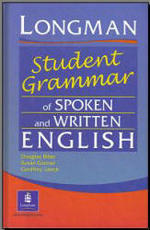 Longman Student Grammar of Spoken and Written English - Douglas Biber, Susan Conrad, Geoffrey Leech - 2003 — Longman Student Grammar of Spoken and Written English - 2003. Douglas Biber, Susan Conrad, Geoffrey Leech This book is a … Книги по английскому языку
Longman Student Grammar of Spoken and Written English - Douglas Biber, Susan Conrad, Geoffrey Leech - 2003 — Longman Student Grammar of Spoken and Written English - 2003. Douglas Biber, Susan Conrad, Geoffrey Leech This book is a … Книги по английскому языку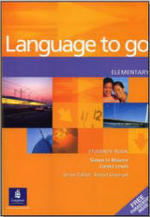 Language to go - Elementary - Student’s book - Simon le Maistre, Carina Lewis — Language to go - Elementary - Student s book. Simon le Maistre, Carina Lewis. 2002. 40 lessons, each on a … Книги по английскому языку
Language to go - Elementary - Student’s book - Simon le Maistre, Carina Lewis — Language to go - Elementary - Student s book. Simon le Maistre, Carina Lewis. 2002. 40 lessons, each on a … Книги по английскому языку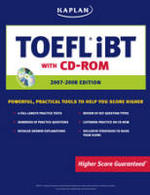 Kaplan TOEFL iBT — 2006, 2007. From the creators of the 1 TOEFL course... TOEFL iBT Exam is Kaplan s comprehensive guide to preparing … Книги по английскому языку
Kaplan TOEFL iBT — 2006, 2007. From the creators of the 1 TOEFL course... TOEFL iBT Exam is Kaplan s comprehensive guide to preparing … Книги по английскому языку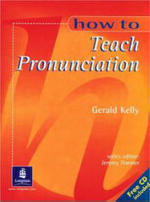 How To Teach Pronunciation - Gerald Kelly — How To Teach Pronunciation. Gerald Kelly. 2001. This book aims to help teachers gain theoretical knowledge and to confirm and … Книги по английскому языку
How To Teach Pronunciation - Gerald Kelly — How To Teach Pronunciation. Gerald Kelly. 2001. This book aims to help teachers gain theoretical knowledge and to confirm and … Книги по английскому языку
Предыдущие статьи:
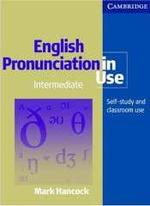 English Pronunciation in Use - Intermediate - Mark Hancock — English Pronunciation in Use - Intermediate. Mark Hancock. 2003. English Pronunciation in Use is a comprehensive reference and practice book … Книги по английскому языку
English Pronunciation in Use - Intermediate - Mark Hancock — English Pronunciation in Use - Intermediate. Mark Hancock. 2003. English Pronunciation in Use is a comprehensive reference and practice book … Книги по английскому языку Cutting Edge - Starter - Student’s book - Sarah Cunningham, Chris Redston, Peter Moor — Cutting Edge - Starter - Student s book. Sarah Cunningham, Chris Redston, Peter Moor Cutting Edge is a multi-level general … Книги по английскому языку
Cutting Edge - Starter - Student’s book - Sarah Cunningham, Chris Redston, Peter Moor — Cutting Edge - Starter - Student s book. Sarah Cunningham, Chris Redston, Peter Moor Cutting Edge is a multi-level general … Книги по английскому языку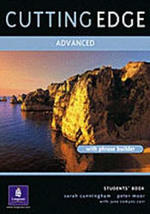 Cutting Edge - Advanced - Student’s book - Sarah Cunningham, Peter Moor, C Carr — Cutting Edge - Advanced - Student s book. Sarah Cunningham, Peter Moor, C Carr Cutting Edge is a multi-level general … Книги по английскому языку
Cutting Edge - Advanced - Student’s book - Sarah Cunningham, Peter Moor, C Carr — Cutting Edge - Advanced - Student s book. Sarah Cunningham, Peter Moor, C Carr Cutting Edge is a multi-level general … Книги по английскому языку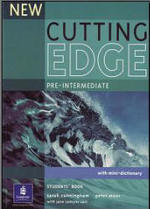 New Cutting Edge, Pre-Intermediate, book for students, Sarah Cunningham, Peter Moor, Carr — New Cutting Edge - Pre-Intermediate - Student s book. Sarah Cunningham, Peter Moor, C Carr Teachers around the world trust … Книги по английскому языку
New Cutting Edge, Pre-Intermediate, book for students, Sarah Cunningham, Peter Moor, Carr — New Cutting Edge - Pre-Intermediate - Student s book. Sarah Cunningham, Peter Moor, C Carr Teachers around the world trust … Книги по английскому языку

